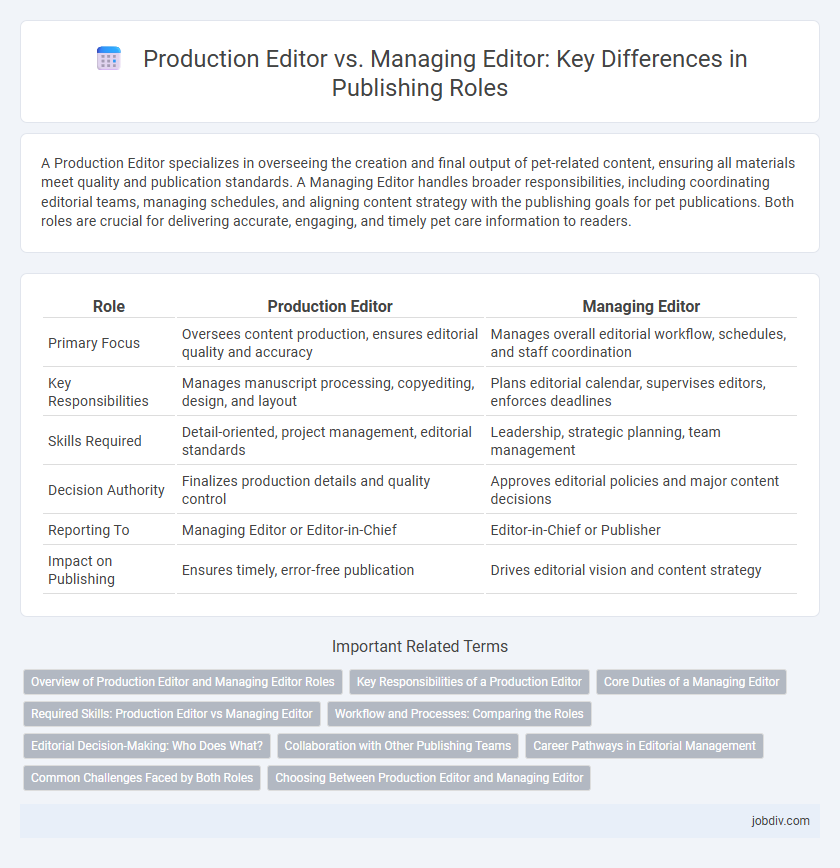A Production Editor specializes in overseeing the creation and final output of pet-related content, ensuring all materials meet quality and publication standards. A Managing Editor handles broader responsibilities, including coordinating editorial teams, managing schedules, and aligning content strategy with the publishing goals for pet publications. Both roles are crucial for delivering accurate, engaging, and timely pet care information to readers.
Table of Comparison
| Role | Production Editor | Managing Editor |
|---|---|---|
| Primary Focus | Oversees content production, ensures editorial quality and accuracy | Manages overall editorial workflow, schedules, and staff coordination |
| Key Responsibilities | Manages manuscript processing, copyediting, design, and layout | Plans editorial calendar, supervises editors, enforces deadlines |
| Skills Required | Detail-oriented, project management, editorial standards | Leadership, strategic planning, team management |
| Decision Authority | Finalizes production details and quality control | Approves editorial policies and major content decisions |
| Reporting To | Managing Editor or Editor-in-Chief | Editor-in-Chief or Publisher |
| Impact on Publishing | Ensures timely, error-free publication | Drives editorial vision and content strategy |
Overview of Production Editor and Managing Editor Roles
The Production Editor oversees the development and scheduling of content, ensuring that manuscripts move efficiently through editing, design, and printing stages. The Managing Editor is responsible for overall editorial operations, coordinating between departments, managing budgets, and maintaining publication standards and deadlines. Both roles are essential in publishing workflows, with the Production Editor focusing on tactical execution and the Managing Editor handling strategic management.
Key Responsibilities of a Production Editor
A Production Editor oversees the entire publishing process, managing timelines, coordinating between authors, designers, and printers to ensure smooth workflow and timely delivery. They handle content organization, copyediting, proofreading, and formatting to maintain quality and consistency across all publications. Their role is crucial in adapting manuscripts for print or digital formats, monitoring project milestones, and resolving production issues.
Core Duties of a Managing Editor
The managing editor oversees the entire editorial production process, ensuring deadlines are met, content quality is maintained, and editorial policies are enforced. They coordinate between editorial teams, production editors, and stakeholders to streamline workflow and manage budgets. Core duties include strategic planning, resource allocation, and supervising content scheduling to drive efficient publication cycles.
Required Skills: Production Editor vs Managing Editor
A Production Editor requires expertise in copyediting, layout design, and project management software to ensure the publication meets quality standards and deadlines. A Managing Editor must possess strong leadership, strategic planning, and communication skills to oversee editorial workflows and coordinate between departments. Both roles demand attention to detail and a deep understanding of the publishing process, but the Managing Editor emphasizes team management while the Production Editor focuses on content refinement and production logistics.
Workflow and Processes: Comparing the Roles
Production Editors oversee the detailed coordination of the publishing workflow, ensuring manuscripts move efficiently through stages like copyediting, typesetting, and proofreading. Managing Editors direct broader processes, managing editorial calendars, team coordination, and aligning production timelines with strategic publishing goals. Both roles optimize workflow, but Production Editors focus on process execution while Managing Editors emphasize overall project management and editorial strategy.
Editorial Decision-Making: Who Does What?
Production editors oversee the implementation of editorial decisions by managing the workflow, coordinating with designers, and ensuring timely publication, while managing editors hold authority over content quality and editorial policies, making final decisions on what gets published. Managing editors collaborate closely with editorial teams to set deadlines, approve content, and shape the publication's overall direction. Production editors translate these strategic decisions into actionable production schedules, ensuring the publication process runs smoothly and meets established standards.
Collaboration with Other Publishing Teams
Production Editors coordinate closely with editorial, design, and marketing teams to ensure seamless content flow and timely publication. Managing Editors oversee broader collaboration across departments, including editorial, sales, and distribution, to align production schedules with strategic goals. Both roles require effective communication and teamwork to maintain high-quality publishing output and meet deadlines.
Career Pathways in Editorial Management
Production Editors specialize in overseeing the workflow and technical aspects of content creation, ensuring timely and accurate publication, while Managing Editors focus on coordinating editorial teams, strategic planning, and maintaining the overall quality and consistency of content. Career pathways for Production Editors often lead to roles such as Senior Production Manager or Publishing Operations Director, emphasizing project management and process optimization. Managing Editors commonly advance to Editorial Director or Publisher positions, where leadership in content strategy and organizational management is key.
Common Challenges Faced by Both Roles
Production Editors and Managing Editors often grapple with tight deadlines, requiring meticulous coordination to ensure timely content delivery across platforms. Both roles must address quality control challenges, balancing editorial standards with resource constraints to maintain publication integrity. Effective communication and workflow management remain critical obstacles, as they coordinate between editorial teams, authors, and designers to streamline the production process.
Choosing Between Production Editor and Managing Editor
Choosing between a Production Editor and a Managing Editor depends on the specific needs of the publishing project, as the Production Editor specializes in overseeing the technical aspects of content development and ensuring timely delivery of manuscripts, while the Managing Editor focuses on coordinating the editorial team, managing schedules, and maintaining overall workflow efficiency. For projects requiring meticulous attention to detail in formatting, proofreading, and production schedules, a Production Editor provides critical support. Conversely, organizations emphasizing strategic planning, team leadership, and holistic project management benefit more from the Managing Editor's expertise.
Production Editor vs Managing Editor Infographic

 jobdiv.com
jobdiv.com